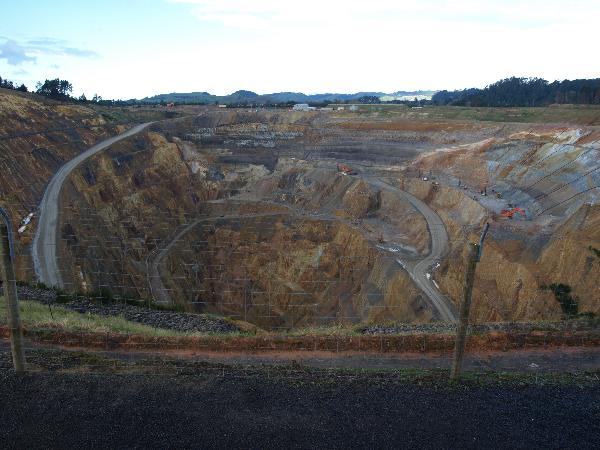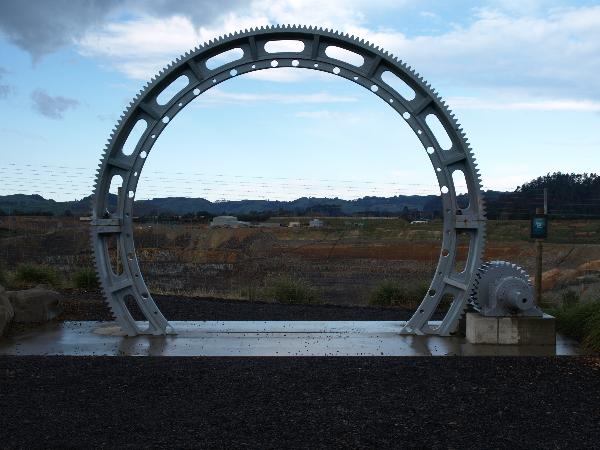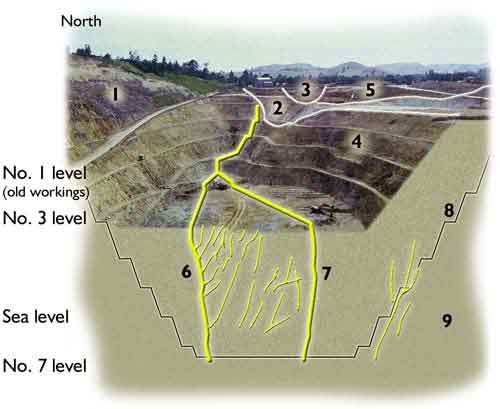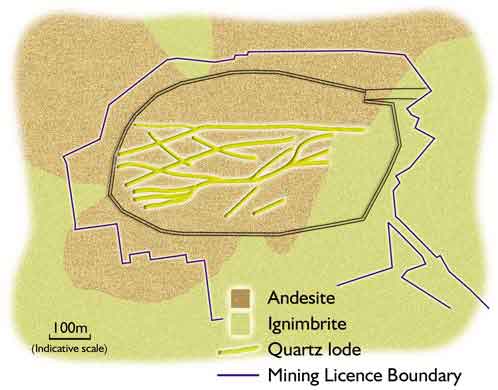Unfortunately the information signs are currently missing but you can find out more info from the Education Centre on Seddon St opposite the historic Cornish Pump House, Waihi, or visit their website: Martha Mine Or maybe some information is right here on this cache page!
There is a whiteboard nearby that shows you the times they do blasting - it is quite safe!

Gold was first discovered on Pukewa (Martha Hill, Waihi) in 1878 by prospectors John McCombie and Robert Lee. The samples of rock they had sent to be assayed were not considered worthwhile, so they left the area. Their claim was taken over by William Nicholl in 1879. He pegged out five acres, named the claim 'Martha' after a family member, and later a few small claims amalgamated to form the Martha Company. By 1882 the first battery was in operation. In 1890 the Martha Company and other claims were bought by the Waihi Gold Mining Company of London, who invested a great deal of capital into the mine.
By 1894, the Forrest / MacArthur process had been developed and the use of cyanide in the gold extraction process was adopted world wide. This process enabled a higher percentage of gold and silver to be extracted from hard rock, making many operations viable that would otherwise have had to close. The Martha Mine became one of the most important gold and silver mines in the world. By 1952, when the mighty Martha Mine closed, around 5.6 million ounces (174,160kg) of gold and 38.4 million ounces (1,193,180kg) of silver had been produced from 11,932,000 tonnes of ore.
Mining did not end in 1952 because the Martha had run out of gold; the current operation is evidence of this. Rather, a series of factors led to a decline in production:
• the international gold price was fixed at $US35 an ounce, limiting the revenue the mine could make
• the machinery needed to be updated; although the technology was available to do this, the money was not
• there had been two World Wars and the Depression of the 1930s, depleting manpower and creating a difficult economic climate.
It was not possible, given these factors, to profitably mine the lower grade ore.
In the 1970s and early 1980s the gold price increased. Exploration and prospecting work identified the economic resource that is being worked today.

In the 2000 calendar year the Martha Mine produced approximately 104,000 ounces of gold and 804,000 ounces of silver. The Martha Project was the first major hard rock mining operation to be commissioned following the resurgence of the gold mining industry in New Zealand in the late 1970s. The Martha Mine is situated in the township, and the Processing Plant, Waste Disposal Area, and Water Treatment Plant are located two kilometres away in a rural area. Because of its location, the mining operation has received a high level of public scrutiny. This is reflected by the stringent conditions set for the project.
Geology of the Martha Mine
Millions of years ago, during the Miocene Period, a thick sequence of volcanic lavas, breccias and tuffs of generally andesitic composition was deposited to form the bedrock of Waihi and surrounding districts. Some considerable time later earthquake activity formed numerous near-vertical planar fractures in the bedrock which became channels for large volumes of ascending geothermal water. The old land surface, high above the present Martha Mine, would have resembled Rotorua, with hot pools, steaming ground, and geysers.
As the dissolved mineral-rich water ascended, cooled and the pressure released, many minerals came out of solution. They deposited or crystallized on the sides of the fractures. The predominant minerals were quartz (SiO2 ) and calcite (CaCO3 ). Gold and silver crystalized as electrum (Au-Ag alloy), native gold (Au) and acanthite (Ag2S). The geothermal fluids also altered the chemistry of the rocks they passed through, forming minerals like pyrite (FeS2 ), adularia feldspar (KAlSi3O8 ), calcite, chlorite and illite clay. Many of these mineral-filled fractures (or veins) intersected to form a complex lattice frame-work deep underground.The largest vein (Martha Lode) reached dimensions of at least 1.6km long by 600m deep and up to 30m wide.
Millions of years of erosion removed hundreds of vertical metres off the volcanic rock sequence and progressively exposed the quartz vein lattice. Being relatively resistant to erosion, this lattice caused an ancient topographic high. Cold surface ground waters percolating down caused oxidation reactions in the andesite, changing it from a blue-grey to an orange-brown colour through the oxidation of pyrite to limonite.
Extremely violent rhyolitic volcanism during the Pliocene epoch resulted in thick, welded ignimbrite deposits covering the Waihi basin. These filled in old river valleys and probably even covered the ancient Martha Hill. Erosion continued to lower and shape Martha Hill. Distant volcanism deposited several thick layers of volcanic ash over the area.
The complex myriad of veins within Martha comprises an epithermal gold-silver orebody which is giant by world standards. The larger veins were extensively, but not completely, mined out by underground methods between 1878 and 1952. Numerous smaller veins remained untouched by the previous miners and are today able to be extracted by selective open-pit mining methods. Material containing as little as one gram of gold per tonne of rock is able to be mined and milled economically using modern technology. In 1999 the mining operation extracted 930,000 tonnes of ore, averaging three grams of gold and 30 grams of silver per tonne.
Cross Section through Martha Mine

1. Unoxidised andesite. 2.Welded ignimbrite. 3. Recent fill. 4. Oxidised andesite. 5. Volcanic ash. 6. Martha lode. 7. Welcome lode. 8. Extended pit outline. 9. Propylitically altered andesite.

Understanding the local geology is a very important part of the Martha Mine project both economically and environmentally. The geology of the site will affect mining, processing, and the ways in which waste rock, tailings and water are managed. It is also an important aspect of rehabilitation plans.
Once you complete the following EarthCache requirements you can post your find without delay, as per the EarthCache guidelines. You will also need to verify your find by sending us a message with your answers to these questions and we will answer in due course:
1. Email us the answers to the following questions making sure you use the text "Martha Gold and Silver Mine - GC1G06V" in your email:
a. How many ounces of gold and how many ounces of silver were extracted in the year 2000.
b. What is the model and serial number of the Caterpillar Truck at the approximate GZ?
c. How many hours and road miles did it do during its working life?
d. How much does it cost to replace 1 tyre?
2. (Optional). Take a photo of yourself and your GPS standing in the large gear cog with the mine in the background. Post the photo with your log.
Please DO NOT post answers with your log - just post your photo.